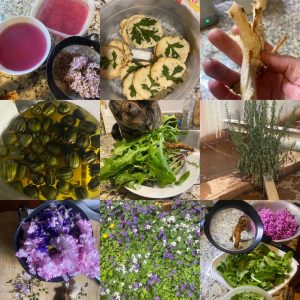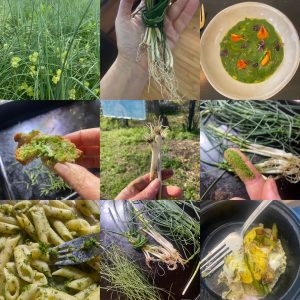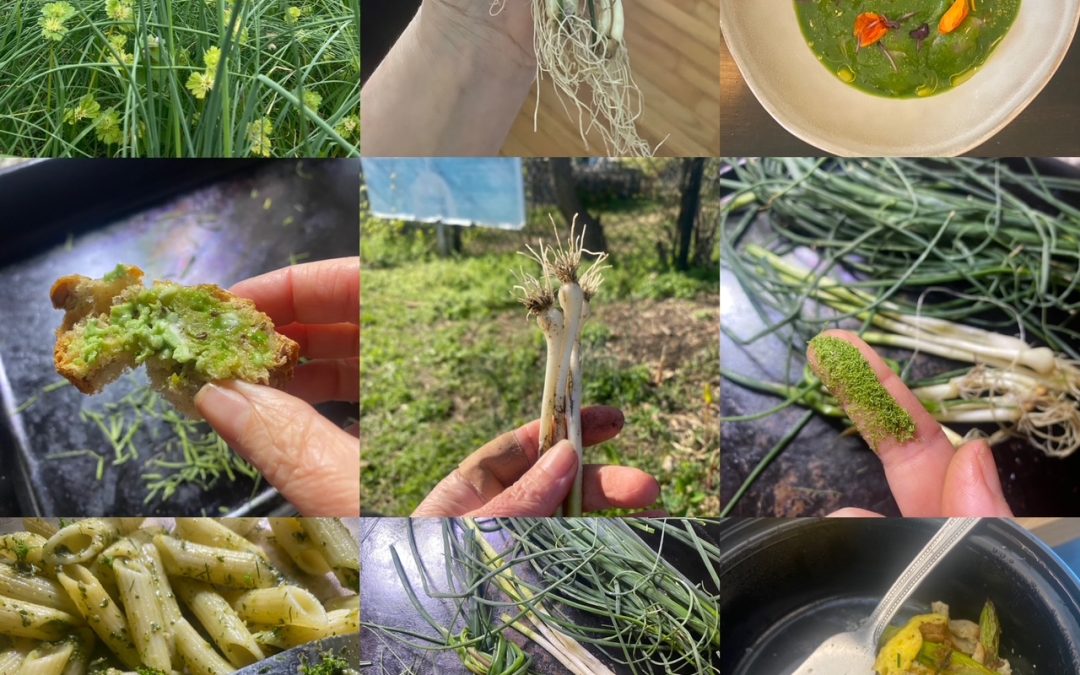Happy April, food & foraging friends!
Yes, I’m a happy April, because tomorrow’s my birthday!
Sometimes life gives you ramps; sometimes it gives you onion grass. I was supposed to go ramp hunting with a friend this weekend, but ended up being one of a few cancelled plans, so I instead leaned in to what I’ve taken to calling poor woman’s ramps.
While ramps (Allium tricoccum, sometimes called wild leeks) are a native plant to be foraged sparingly, onion grass (Allium vineale, aka field garlic or crow garlic) is a lawn invader that can be eaten with abandon (including its tiny bulbs, chive-like leaves and, later in the season, a frizzy-haired flower that looks like it put its finger in a socket).
The two species look nothing alike, as ramps have two short, flat, wide leaves and the onion grass has hollow, tall and skinny leaves in bunches like chives. Yet they both share the common characteristic of all 1,000-something allium species, including commercial onions, garlic, chives and leeks: smelling oniony. No other plant will have and no allium will not have that distinctive aroma, so it’s what I call a tell. Here’s some research comparing the volatile oils of wild alliums, if you want to geek out on that.
While ramps have a mellow, complex flavor, onion grass, which is native to Europe, Middle East and North Africa, is pretty potently oniony with a slightly bitter aftertaste. In fact, the meat and dairy of cattle who have foraged it can pick up that garlicky flavor, rendering it tainted for commercial purposes (I wouldn’t mind a garlic-scented steak personally, but milk not so much).
I’ve processed onion grass several ways this week: compound butter, infused oil, and my favorite, onion powder, which is as simple as drying whole leaves simply using my oven light, then powdering it with a spice grinder. Each lends a beautiful, albeit different, shade of green. I also used it fresh in an okonomiyaki recipe (a Japanese cabbage pancake, which was for sale at the fabulous Japanese street festival this weekend). In past seasons I’ve also made Marie Viljoen‘s much recommended onion marmalade. I’ve got some goat cheese in the fridge and think I’ll use the remaining wild onion in this dip recipe to go on Marie’s mugwort crackers.
The medicinal properties of allium have been attributed to the abundance of sulfur-containing compounds, which have antifungal, antibacterial, antiparasitic, antiviral, and other bad-guy-fighting benefits. So go wild on that; your grandmother was right to tell you to eat raw garlic when you’re sick.
For a taste of rich man’s onions (see what I did there), check out my fellow forager friends’ restaurant Poplar this month. This week I had a fantastic hiramisu aguachile with a ramp marinade that Chef Iulian made from ramps, cucumber, unripe strawberries and jalapeno. Poplar has a grilled ramps with carrot romesco I understand will stay on the menu for a minute (usually the menu changes 100% every week).


Everything wild seems to be everywhere all at once – mugwort, redbuds, cherry blossoms, violets, dandelions, mint, and Japanese knotweed, to name a few. (Yes, it’s morel season too, but I’m just counting my neighborhood blessings right now since I’ve had no time in the woods lately.)
I’ve been putting in overtime in my kitchen as I’m testing recipes for a friend’s upcoming wild foods cookbook, in addition to churning out cordials, crackers, cookies, and more with my spring finds. We’ll cover common spring edibles in my all-but-sold-out I Hate Tax Day walk this Tuesday and my now-classic cider and foraging workshop at ANXO April 29.
As per my earlier memo, my birthday is tomorrow (Aries make sure you never forget), and carrot cake is my favorite – my Bagelz and Jam improv hostess had a juicy hunk of it for me today! Fortuitously, I stumbled on this dandelion root cake recipe while looking for new uses for the prolific dandelions coming up.
With the recent rain, some roots come right up and some you gotta dig deep for (a metaphor for life right now). My late father gave me a Japanese hori hori knife for my birthday one year so seemed apropos to use that to uproot a birthday cake ingredient. Dandelion root is surprisingly sweet, considering its bitter leaves; the above cake recipe subs it in for carrots. If I manage to yank up enough of these little scraggly roots to bake it, I’ll report back next month.
Happy Birthday to me, and Happy Easter, Happy Passover, and Happy DC Emancipation Day to you! And may our May be more sweet than bitter.
Wildly yours,
April
PS: If you are new to my mailing list – welcome! You were added if you signed up for one of my workshops but can unsubscribe at any time using the link below. If you like what you’re reading, check out past editions here. If you’ve been a subscriber for a while, you may notice I recently moved from Mailchimp to Mailerlite. Please be sure to whitelist this email so it doesn’t go to spam.
PPS: My favorite holiday besides my birthday is April Fool’s Day: check out what I cooked up for Bloom this year!
***
Image Block 1: Wild onion/field garlic is surprisingly versatile, and can be subbed in as chives, made into onion powder, used in broth, compound butter and more. Top right dish was made with a luscious, spicy ramp marinade, wild onion’s upscale cousin, at Poplar.
Image Block 2: Wild ingredients abound right now, especially edible flowers like violets, redbuds, cherry blossoms and dandelions. All parts of the dandelion are edible, bud, leaf, flower, stem and root.

